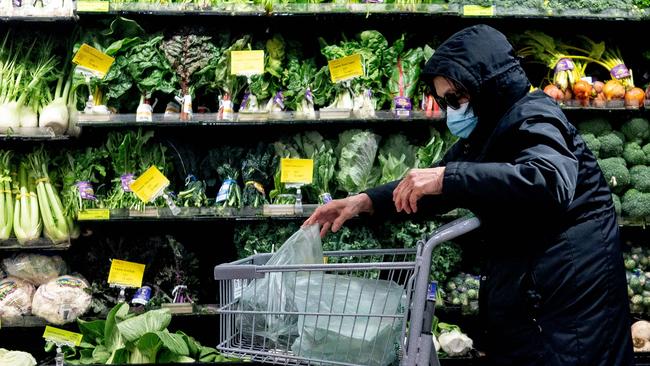Fiscal stimulus is turning into a fiscal drag, in a big headwind for growth
Drop in federal relief could help curb inflation, while elevated savings should blunt impact on consumers.

The federal pandemic support that helped propel the economy to blistering growth last year and put upward pressure on inflation is rapidly waning. That will weigh on consumers this year, pulling growth down though not by enough to knock the recovery off track, economists say.
Inflation-adjusted gross domestic product rose 5.5% in the fourth quarter from the same period a year earlier, its best annual rate since 1984. That was supported by roughly $US3.6 trillion in federal spending in response to Covid-19 since the pandemic’s start, including direct support to households via stimulus checks, enhanced unemployment benefits, monthly child tax-credit payments, and aid to state and local governments.
But Americans have been spending down some of that aid, and many assistance programs have expired. Meanwhile, despite calls from some industry groups for additional aid, Congress is yet to advance another large-scale relief package. Mr Biden’s proposal for a major social, education and climate change bill is also stalled in Congress.
By the fourth quarter of 2021, the various Covid-19 relief packages enacted since 2020 had boosted the level of US GDP by just under 6 percentage points, said David Mericle, chief US economist at Goldman Sachs. Mr Mericle estimates by the end of 2022 that boost will shrink to a little less than 2 percentage points. That’s equivalent to 4 percentage points of drag on economic growth compared with what would have been if pandemic programs offered the same support as in 2021.
“That is a pretty big pullback in the level of fiscal support to the economy,” Mr Mericle said. “Our base case is that other factors can offset that and the economy will keep growing, but it is a lot to contend with.” Goldman expects GDP to grow 2.2% in the fourth quarter of this year from a year earlier. The average of economists surveyed by The Wall Street Journal in January was 3.3%.
Joseph LaVorgna, chief economist for the Americas at Natixis, forecasts even lower growth, of around 1.5%, mostly because of waning fiscal support.
“I think it is fair to say that the fiscal shock is going to be in historic proportions,” Mr LaVorgna said.
Robert Dent, a senior US economist at Nomura Securities, put the hit to this year’s growth from declining fiscal support at 2.5-to-3 percentage points. But there is a potential silver lining. Past fiscal support has left Americans with a financial cushion of $US2.4 trillion at the end of 2021 in accumulated savings in excess of pre-pandemic trends, Nomura estimates.
“Consumers are sitting on a lot of excess savings that we expect to be spent down a little bit this year, and that should offset some of that negative impact from fiscal drag,” Mr Dent said.
He also noted the economy could get a boost depending if state and local governments draw down cash from better-than-expected budget results during the pandemic and federal aid. The Treasury Department, for example, distributed more than $US240bn in pandemic aid to state and local governments last year and is set to deliver a second tranche this year.
Still, with consumer prices rising at the fastest pace since February 1982, “the really big risk for this year is that consumers don’t dip into those excess savings as much as we anticipate because of concerns about inflation,” Mr Dent said.

Some economists and legislators say fiscal stimulus, in particular the $US1.9 trillion bill President Biden signed into law last March, contributed to inflation’s rise to 7.5% in January. That suggests fiscal drag may help restrain inflation.
“Fiscal policy is going to be less supportive of growth this year,” Fed Chairman Jerome Powell told a news conference last month. That is one of “multiple forces which should be working over the course of the year for inflation to come down,” he added. The Fed is expected to start a series of interest-rate increases next month.
Some slowing in growth was expected since, in part thanks to fiscal stimulus, overall economic activity has quickly returned to its pre-pandemic trend and unemployment has fallen to 4%, a level below which Fed officials expect wage and price pressures to intensify. Economists expect that even with fiscal drag, unemployment will keep falling this year.
Michael Montani, a managing director at Evercore ISI, estimates US households received roughly $US1 trillion in incremental pandemic-related payments in 2021 through programs such as stimulus checks and child tax credits. He estimates 25% to 30% of that aid made its way into sales at US retailers, excluding autos, gas and restaurants, providing a boost to the industry last year of about $US250bn to $US300bn.
Fiscal drag will hold down the growth of nominal retail sales this year to 4%, from 2021, Mr Montani estimates. However, the pattern over the course of the year will be uneven. In the first half growth will be lower than the same period in 2021 primarily because Americans won’t be receiving stimulus checks, like they did last year. But after working through “the teeth of the impact of some of this extra stimulus,” sales growth will pick up in the second half, he said.
The possibility of additional fiscal support this year is also still on the table, although prospects are uncertain. The Biden administration and Democrats, for example, have sought to salvage parts of the social, education and climate package. That includes a push to continue the monthly child tax-credit payments by exploring changes to the program that would appease Sen. Joe Manchin (D., W.Va.), whose support is needed in a closely divided Senate.
Mr Mericle, of Goldman Sachs, said had the entire package become law, it would have reduced the impact of fiscal drag this year by about half a percentage point.
“The basic story that 2022 would be a year of substantial reduction in fiscal support would still be the case,” he said.
The Wall Street Journal




